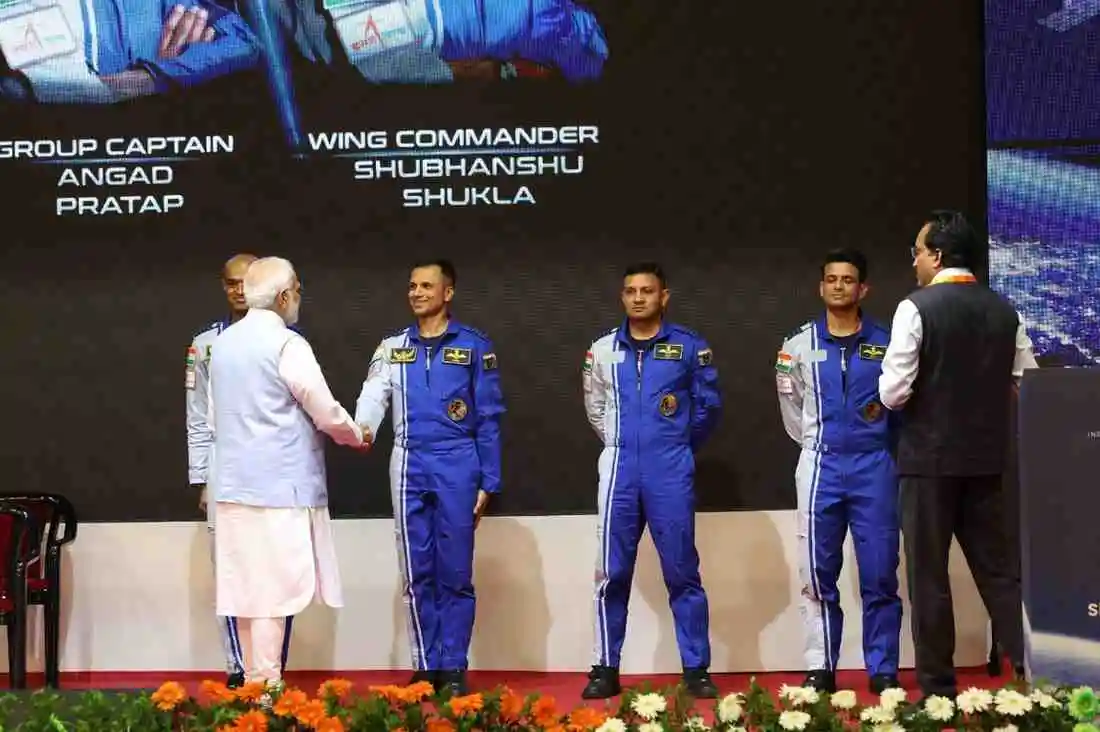All Indian Space Lovers, UNITE! The Gaganyaan mission, which is planned for launch in 2025, will watch Indian heroes fly among the stars.Imagine being picked from hundreds of others to be sent on a mission unlike any other. But who are the brilliant people behind this amazing achievement?
- Group Captain Prashanth Balakrishnan Nair
- Group Captain Ajit Krishnan
- Group Captain Angad Pratap
- Wing Commander Shubhanshu Shukla
1984 🇮🇳 astronaut – Rakesh Sharma
Flew to space on soviet mission2024 🇮🇳 astronauts revealed
PRASANTH BALAKRISHNAN NAIR
ANGAD PRATHAP
AJITH KRISHNAN
SHUBHANSHU SHUKLA
All are #IndianAirForce pilots pic.twitter.com/vsZalFxTsm
— Sidharth.M.P (@sdhrthmp) February 27, 2024
Gaganyaan Mission: When the Training got Super Hard
Space Classroom
Imagine studying for a super important exam, but instead of textbooks, you have spaceships and space travel! Our super-smart astronauts learnt everything about the Gaganyaan spacecraft, from its buttons and switches to how it moves around Earth. They also became experts in space science, understanding things like how objects float in space and why astronauts need special suits.
Just like we learn about gravity in school, astronauts learnt about microgravity, the feeling of weightlessness experienced in space. They even got to experience this feeling for short periods during special airplane flights called parabolic flights!
High-level Fitness &Survival Training
Being an astronaut isn’t just about being smart; it’s about being super strong and fit too! Imagine experiencing the feeling of being pushed five times your weight during launch! As Pilots, they were quite fit already, but space game is different. Astronauts trained on special machines that simulate intense G-forces. Like athletes, Indian astronauts built the strength and stamina they need to deal with the shocking forces of launch and re-entry.
Mission Simulators
How much we all love playing a super realistic video game, but instead of controlling a character, our astronauts practiced flying a real spaceship with mission simulators. These incredible machines created a virtual world that looks and feels just like being inside the Gaganyaan spacecraft in space.
They rehearsed everything that happens during launch, from starting the engines to reaching orbit around Earth.Simulators tested the astronauts’ skills by throwing unexpected challenges their way, like things going wrong with the equipment or facing an emergency situation. This helped them to practice for staying calm under pressure to solve problems!
Handling the Spacesuit
Gaganyaan Spacesuits are like a tiny, personal spaceship worn by our astronauts. They have their own special systems to keep our heroes alive and comfortable in space:
Communication devices: This will allow astronauts to talk to mission control back on Earth, just like using a walkie-talkie, but way cooler!
Heating and cooling systems: Space can be extremely hot or cold, so these systems will keep the astronauts at a comfortable temperature, similar to how an air conditioner keeps our home cool in the summer.
Bonus Training
Astronauts didn’t stop learning after they mastered the basics! To make the mission successful, they have learnt first aid skills like CPR and how to give medicine, so they can take care of themselves and their crewmates if anyone gets sick or hurt. They even learnt to use special tools like ultrasound machines to verify on each other’s insides, just like real doctors do!
They did Yoga too, which helps to stretch and become more flexible. But that’s not all! Yoga also helped them to focus better and stay calm, which is super important when they will move through space at thousands of miles per hour!
Indian astronauts training video in Russia and India for the past 2 years for Gaganyaan mission. @isro pic.twitter.com/k2BdFiTDoN
— Indian Tech & Infra (@IndianTechGuide) February 28, 2024
Conclusion
The latest update on India’s Gaganyaan mission brings promising news as the Indian Space Research Organisation (ISRO) has successfully completed a test launch and recovery of a crew module. This significant achievement marks a critical step forward in realizing India’s first human space flight project. Originally delayed due to the COVID-19 pandemic, the mission is now slated for launch in the fourth quarter of 2024.
In addition to the successful crew module test, ISRO has announced another crucial milestone: the CE20 cryogenic engine, which will power the upper stage of the LVM3 vehicle, has been officially ‘human-rated’. This designation indicates that the engine meets the stringent safety and reliability standards required for carrying astronauts.
The human-rating of the CE20 cryogenic engine is equally significant. Cryogenic engines are known for their efficiency and high performance, and the CE20’s certification confirms it is ready to safely propel the crewed mission’s upper stage. This development underscores ISRO’s commitment to adhering to international standards of safety and reliability in human spaceflight.
As the mission progresses, these advancements highlight ISRO’s meticulous preparation and robust testing protocols. The forthcoming months will likely see further tests and refinements, all geared towards the safe and successful execution of the Gaganyaan mission.










